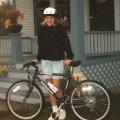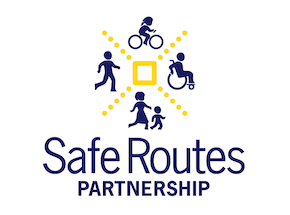 We love it when Safe Routes to School volunteers and champions share what is happening in their community with us!
We love it when Safe Routes to School volunteers and champions share what is happening in their community with us!
Resource Library
The Indiana Safe Routes to School program is alive and well! Having completed six application rounds since its inception in 2006, there are now 114 infrastructure projects and non-infrastructure activities that have been awarded funding in the Hoosier State. For a map of Indiana’s Safe Routes to School awards click here.
All Safe Routes to School programs benefit from evaluation. Thoughtful data collection and analysis helps communities to identify issues, appropriate strategies to address those issues, set goals, and determine results. Data collected can further influence funding by providing a fuller picture of community needs and prospective projects.
In our upcoming September webinar, we will delve into tools to support your funding applications and existing programs. The one-hour session will include an overview of Colorado’s EnviroScreen, an interactive environmental justice mapping and health screening tool developed for the Colorado Department of Public Health and Environment (CDPHE). This dynamic resource enables users to identify areas with current and past environmental inequities, pinpoint areas where disproportionately impacted communities have a greater health burden and/or face more environmental risks and identify geographic areas that meet the definition of disproportionately impacted communities under Colorado law.
Additionally, given the closure of the National Safe Routes to School Data System, we will be discussing new means of recording student travel tallies and parent surveys. This data is a required component for Colorado Safe Routes to School grant applications. All those interested in submitting applications for our upcoming Colorado Safe Routes to grant cycle, join us as we share our suggestions to help you prepare your best submission!
*Note: While this webinar is designed to give an overview of tools available for evaluation within your program, special attention will be given to attendees preparing a Colorado Safe Routes to School FY 25 Application.
 Safe Routes to School is about walking and bicycling to school and in communities. The Safe Routes to School momentum spreads to players at all levels. There are only three communities with designated Safe Routes to School coordinators in the Greater Washington, DC region.
Safe Routes to School is about walking and bicycling to school and in communities. The Safe Routes to School momentum spreads to players at all levels. There are only three communities with designated Safe Routes to School coordinators in the Greater Washington, DC region.
The Safe Routes to Parks is a research-backed intervention to boost rates of physical activity that can have positive health benefits. In a systematic review, the Community Preventive Services Task Force found a significant increase in physical activity related to parks, greenways, and trails when they are paired with at least one other intervention – community engagement, structured programs, public awareness, and/or access enhancements. Safe Routes to Parks is a programmatic way to apply that research to boost physical activity in your community. This factsheet outlines five actions champions can take to get started.
 This week, Congress is voting on a new two-year transportation bill, called MAP-21, that will make significant changes to federal transportation policy that negatively impact bicycling and walking programs. Please see our joint statement with the America Bikes coalition for information on the effec
This week, Congress is voting on a new two-year transportation bill, called MAP-21, that will make significant changes to federal transportation policy that negatively impact bicycling and walking programs. Please see our joint statement with the America Bikes coalition for information on the effec
The Safe Routes Partnership has pulled together resources to help applicants successfully win Safe Streets and Roads for All funding. In 2025, there is $1 billion available for communities through the Safe Streets and Roads for All program to develop plans and implement strategies to improve roadway safety. Applications are as short as two pages, and chances of success are very high. The deadline is June 26, 2025. The Safe Routes Partnership is here to help you win this funding.
Helpful Information
Frequently Asked Questions
More Information about SS4A
Worksheets
Digital versions of the below worksheets are available to copy and reuse for your community via Google. Google will prompt you to make a copy of the worksheet first.
Want to edit it in Word? Click File > Download
SS4A Implementation Grant Worksheet
SS4A Demonstration Worksheet
 Since Congress released their new MAP-21 Transportation Bill two weeks ago, which eliminated dedicated funding for Safe Routes to School and leaves most of the decision making for active transportation up to states and locals, people have been asking me “what’s next?”
Since Congress released their new MAP-21 Transportation Bill two weeks ago, which eliminated dedicated funding for Safe Routes to School and leaves most of the decision making for active transportation up to states and locals, people have been asking me “what’s next?”

 I have been thinking a lot about how we can ensure Safe Routes to School, walking and bicycling can continue to flourish around the country in our new “MAP-21” world without dedicated funding. So I’ve pulled together a “top 10” list for how Safe Routes to School can survive and thrive.
I have been thinking a lot about how we can ensure Safe Routes to School, walking and bicycling can continue to flourish around the country in our new “MAP-21” world without dedicated funding. So I’ve pulled together a “top 10” list for how Safe Routes to School can survive and thrive.
 It is back to school time in North Carolina and time for an IF/THEN deductive reasoning lesson that will make a difference for all moms, dads and kids heading back to school. Here are three important IF’s and THEN’s
It is back to school time in North Carolina and time for an IF/THEN deductive reasoning lesson that will make a difference for all moms, dads and kids heading back to school. Here are three important IF’s and THEN’s

 The Safe Routes to School Mississippi network prides itself on the ability to connect with those organizations within the state that are passionate about ridding the state of the childhood obesity epidemic.
The Safe Routes to School Mississippi network prides itself on the ability to connect with those organizations within the state that are passionate about ridding the state of the childhood obesity epidemic.
 Seeing all the bicyclists and their interactions at Pro Walk Pro Bike Pro Place, in my home town of Seattle, and many other places I travel makes me wonder. Is bicycling a non-electronic version of social media?
Seeing all the bicyclists and their interactions at Pro Walk Pro Bike Pro Place, in my home town of Seattle, and many other places I travel makes me wonder. Is bicycling a non-electronic version of social media?
Mississippi has certainly been busy with Safe Routes to School initiatives. For starters, they have awarded a total of 39 projects representing 31 communities and 87 schools. They have also had four statewide projects. In the most recent cycles, they awarded $2.5 million involving 12 communities, 26 schools and three statewide partners. The most recent awards were announced in September 2012, which brings their total amount awarded to date to $10.9 million.
 As I continue to work regionally, across two states and a federal district, I am always looking for opportunities where people are already collaborating beyond their own jurisdictional lines. The National Capital Transportation Planning Board (TPB) is the metropolitan planning organization for the Greater Washington, DC region.
As I continue to work regionally, across two states and a federal district, I am always looking for opportunities where people are already collaborating beyond their own jurisdictional lines. The National Capital Transportation Planning Board (TPB) is the metropolitan planning organization for the Greater Washington, DC region.
 They say a picture is worth a thousand words and this one is no exception. This is me on my 16th birthday. Yes, I asked for and was given a bicycle for my 16th birthday.
They say a picture is worth a thousand words and this one is no exception. This is me on my 16th birthday. Yes, I asked for and was given a bicycle for my 16th birthday.
 California’s climate change legislation continues to provide opportunities for bicycle and pedestrian advocates to influence regional transportation policy and finance.
California’s climate change legislation continues to provide opportunities for bicycle and pedestrian advocates to influence regional transportation policy and finance.
This website provides information about pedestrian and bicyclist safety policy and program initiatives by the FHWA.
 I’ve been immersed in our latest progress reports for the regional network project, and it is so easy to get lost in the minutiae of editing. But when I stop and think back upon our efforts this year, I am proud of the work of everyone involved in our regional efforts.
I’ve been immersed in our latest progress reports for the regional network project, and it is so easy to get lost in the minutiae of editing. But when I stop and think back upon our efforts this year, I am proud of the work of everyone involved in our regional efforts.

